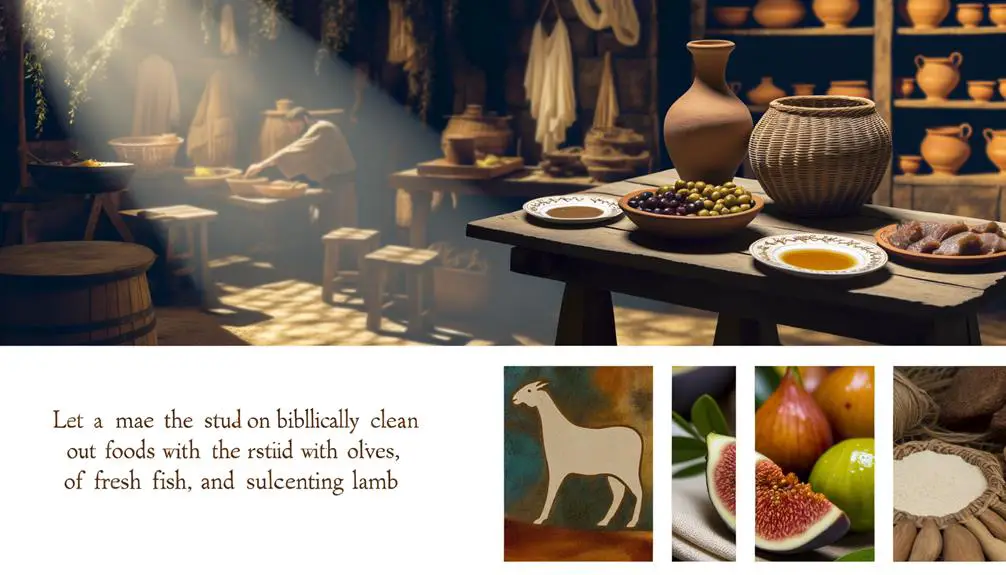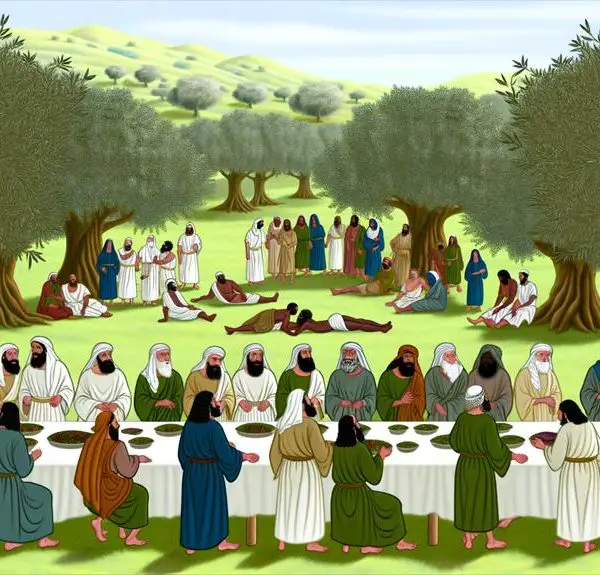This exploration of Biblically clean foods unveils the intricate blend of faith, health, and tradition—discover what sets them apart.

Clean Foods in the Bible
In the Bible, clean foods are outlined primarily in the Book of Leviticus, distinguishing between what you can and cannot consume to maintain both spiritual and physical purity. This guidance showcases an adherence to faith and the desire for communal holiness among the Israelites. Clean animals typically include certain mammals with specific traits, like cloven hooves and chewing cud, as well as various fish that have fins and scales. Adhering to these dietary laws isn't just about tradition; it's deeply tied to health benefits, stressing the consumption of whole, unprocessed foods. Understanding these principles offers more than historical knowledge—it opens insights into holistic living.
Key Takeaways
- Clean foods in the Bible are defined by specific traits, such as cloven hooves and chewing cud for land animals.
- Sea creatures must have fins and scales to be considered clean.
- Birds like doves and pigeons are deemed clean; birds of prey are not.
- Certain insects, specifically locusts, crickets, and grasshoppers, are permitted for consumption.
- These dietary laws from Leviticus emphasize spiritual purity and obedience to divine commands.
Biblical Basis of Clean Foods

Exploring the concept of clean foods, the Bible provides specific dietary guidelines that distinguish between permissible and forbidden foods for consumption. You'll find that these guidelines are not just arbitrary but steeped in a rich historical context and cultural significance which reflects the practices and beliefs of the ancient Hebrews.
The notion of clean and unclean foods has its foundations in the desire to maintain purity, both physically and spiritually. This distinction likely served several practical purposes, such as preserving health and differentiating the Hebrew people from their neighbors. The dietary laws provided a daily, personal way for followers to demonstrate their obedience and commitment to their faith.
Understanding these food laws, you'll appreciate how they greatly influenced Jewish culture and religious identity. These laws weren't merely about nutrition; they were deeply embedded in the social fabric and spiritual life of the community. They shaped rituals, influenced social structures, and even affected trade and economics within and outside the community.
As you explore further, you'll see that these dietary instructions provided a framework for ethical and moral living, guiding adherents in their interactions both within their community and in the broader context of their geographical neighbors.
Understanding Levitical Dietary Laws
Why are the Levitical dietary laws significant in understanding the broader context of Biblical cleanliness and purity? These rules, found mainly in the Book of Leviticus, aren't just ancient dietary guidelines but serve as a profound demonstration of the Israelites' call to holiness and separation from other nations. In the historical context, these regulations not only structured the daily lives of the Israelites but also reinforced their unique identity in a landscape filled with diverse cultures and religious practices.
To appreciate these laws fully, it's essential to compare them with contemporary cultural norms. Other ancient civilizations, like the Egyptians and Babylonians, had their dietary prescriptions, often linked to their religious and social structures. However, the Levitical code was distinct in its rationale and strictness, aimed at preserving the spiritual and communal purity of the Israelites.
Health Implications of Biblical Diets

As you explore the health implications of biblical diets, you'll find that these ancient prescriptions offer more than spiritual benefits. They are associated with nutritional advantages that potentially aid in disease prevention and could even impact longevity and lifestyle. Each point, from nutritional benefits to insights on disease prevention, reflects a holistic approach to health that intertwines physical well-being with spiritual adherence.
Nutritional Benefits Explored
While the Bible primarily discusses spiritual and ethical life, it's important to ponder how its dietary guidelines can greatly influence modern health. The foods deemed clean in biblical times were not only spiritually significant but also offer substantial health benefits in today's context. Here are three key aspects:
- Balanced Nutrition: Biblical diets are rich in vegetables, fruits, grains, and lean meats, providing a well-rounded nutritional profile.
- Natural Foods: Emphasis on whole, unprocessed foods contributes to lower intake of additives and preservatives.
- Moderation and Variety: The dietary laws encourage moderation and diversity, crucial for maintaining health.
Understanding this historical context enhances its contemporary relevance, ensuring you're not just nourished spiritually but also physically.
Disease Prevention Insights
Exploring further, it's evident that the diet described in the Bible not only supports balanced nutrition but also plays a significant role in preventing various diseases. Many of the foods highlighted as 'clean' are rich in vitamins and minerals that are essential for maintaining your immune system. For example, fruits like figs and pomegranates, frequently mentioned in biblical texts, are excellent antioxidant sources. These antioxidants help combat oxidative stress, which is linked to numerous chronic diseases. Including such immune-boosting foods in your diet can reduce inflammation and enhance your body's ability to fend off illnesses. By adhering to these dietary guidelines, you're not just following spiritual wisdom but also adopting a lifestyle that supports robust health.
Longevity and Lifestyle
Adopting the dietary principles outlined in the Bible can greatly contribute to a longer, healthier life. When you integrate these timeless nutritional guidelines with modern health practices, you're setting the stage for ideal wellness. Here are key aspects to ponder:
- Balanced Diet: Biblical foods like fruits, vegetables, grains, and lean meats are naturally balanced and nutritious.
- Exercise Routines: Regular physical activity, as suggested by the active lifestyles of many biblical figures, supports overall health.
- Sleep Patterns: Adequate rest is essential; it's reminiscent of the biblical principle of observing a day of rest, which underscores the importance of rejuvenation.
Clean Land Animals Listed

Several land animals are designated as clean for consumption according to biblical dietary laws. You'll find these guidelines rooted in historical consumption trends and animal domestication perspectives, reflecting a deep cultural and religious understanding of dietary suitability. This list of clean animals not only aligns with ancient health practices but also provides insights into the dietary cultures of historical communities.
Here's a concise table of some clean land animals mentioned in the Bible:
Animal |
Characteristics |
|---|---|
Cow |
Cloven hoof, cud-chewing |
Sheep |
Cloven hoof, cud-chewing |
Goat |
Cloven hoof, cud-chewing |
Deer |
Cloven hoof, cud-chewing |
Gazelle |
Cloven hoof, cud-chewing |
These animals, recognized for their specific physical traits such as having cloven hooves and being cud-chewing, meet the criteria set forth in biblical texts. It's intriguing to note how these requirements likely influenced the domestication and breeding practices of these animals, shaping both agricultural and dietary patterns through the ages. Engaging with these texts, you're connecting with a lineage of thought and practice that has deep roots in faith and food history.
Sea Creatures Considered Clean
Moving from land to sea, let's now examine the sea creatures the Bible deems clean for consumption. According to Leviticus 11:9-12 and Deuteronomy 14:9-10, clean sea animals must have both fins and scales. This specific criterion not only reflects dietary laws but also carries religious symbolism, emphasizing purity and distinction.
Here are three key points about these clean sea creatures:
- Variety of Species: You're not limited in your options. Many fish, such as salmon, trout, and haddock, meet these biblical criteria. These species are popular in various cooking methods, ranging from grilling to baking.
- Health Benefits: These fish are often rich in omega-3 fatty acids and lean protein, aligning with the principle of taking care of the body as a temple, a recurring theme in scripture.
- Religious Symbolism: The presence of both fins and scales on these creatures symbolizes a form of biblically endorsed completeness and integrity. This symbolism extends into the spiritual domain, where adherents see the following of these dietary laws as an expression of faithfulness and obedience to divine statutes.
Understanding these guidelines helps you appreciate the deeper layers of meaning behind biblical dietary laws, beyond just the practical aspects of nourishment.
Birds and Cleanliness Criteria

The Bible's criteria for clean birds, laid out in Leviticus 11:13-19 and Deuteronomy 14:11-18, focus on certain species that are permissible to eat. These passages delineate which birds you may consume and those you must regard as unclean. This distinction isn't arbitrary; it's deeply rooted in avian symbolism and the roles these birds play in their ecosystems.
For example, birds of prey are typically listed among the unclean. This classification likely ties to their feeding habits—consuming dead animals—which could be seen as contrary to the purity laws that emphasize health and ritual cleanliness. On the other hand, birds like pigeons and doves, which are permissible, symbolize peace and purity in various scriptural contexts, enhancing their acceptability in diet.
You should also consider the feather functions of these birds. Feathers play critical roles in protection and insulation, but they also have significant cultural and religious symbolism. Clean birds often have feather types that support cleanliness—tight and less likely to trap dirt—reflecting their suitability for consumption under biblical dietary laws.
Understanding these criteria isn't just about following religious directives; it's about recognizing the broader symbolic and practical reasons behind these ancient dietary guidelines.
Insects Permitted in Diet
While most insects are considered unclean, Leviticus 11:20-23 specifies which types you're allowed to eat, including certain locusts, crickets, and grasshoppers. These insects, when mentioned in the Bible, are not only recognized as permissible for consumption but are also highlighted as sources of nutrition in times of need. Understanding the cultural acceptance and methods of insect preparation is essential to appreciate the full context.
Here are three key points to take into account:
- Types of Permitted Insects: Specifically, the types that you can eat include various kinds of locusts, the bald locust, the cricket, and the grasshopper. Each of these has been identified over time with specific characteristics that make them fit for dietary purposes.
- Insect Preparation: The preparation of these insects typically involves cleaning and cooking. Historically, they were either roasted or boiled, depending on the available resources and regional culinary practices.
- Cultural Acceptance: In ancient times, consuming these insects was more widely accepted, especially in desert regions where other forms of protein were scarce. Today, while some cultures continue to embrace these practices, others might find them unusual or even unappealing.
Understanding these aspects helps you appreciate the dietary laws presented in Leviticus and their relevance across different cultures and epochs.
Clean Foods and Ritual Purity

As you explore the intersection of biblical dietary laws and ritual purity practices, it's important to understand the significance these elements hold in scriptural contexts. These laws not only dictate what is considered clean or unclean, but they also serve to reinforce spiritual disciplines within the community. By adhering to these guidelines, followers demonstrate both obedience and reverence towards their faith.
Biblical Dietary Laws
Biblical dietary laws specify which foods are considered clean and detail the rituals associated with purity. These regulations have deep historical context and cultural significance, shaping not only ancient dietary practices but also spiritual and social identities. Here's what you need to know:
- Historical Context: Originating from Levitical laws, these dietary rules were integral in distinguishing the Israelites from neighboring cultures.
- Cultural Significance: The adherence to these laws was a manifestation of faithfulness and a symbol of communal identity.
- Clean Foods: Typically, animals that chew the cud and have cloven hooves are deemed clean, such as cows and sheep; however, creatures like pigs and rabbits are not.
Understanding these laws offers insight into the ancient world and its values.
Ritual Purity Practices
To understand how clean foods contribute to ritual purity, one must explore the practices and beliefs surrounding their preparation and consumption. Within the historical context of ancient Israel, adhering to dietary laws wasn't just about health—it was intrinsically linked to spiritual cleanliness and favor in the eyes of God. You'll find that these regulations helped define the community's identity, setting them apart from neighboring cultures through distinct dietary practices.
Cultural comparisons reveal that similar concepts of food purity exist in various religions, though the specifics may differ. As you explore these ancient texts, you'll notice that the emphasis on purity rituals serves not only a practical function in promoting hygiene but also a deeper, symbolic communication of devotion and obedience to divine law.
Modern Interpretations and Adaptations
You'll find that modern interpretations and adaptations of clean foods in the Bible reflect diverse cultural and dietary shifts. The concept of 'clean' foods, originally tied to ritual purity, now engages with broader themes of health, ethics, and sustainability. As you explore this evolution, ponder how cultural symbolism and contemporary challenges shape these interpretations. Here are three key aspects to ponder:
- Health Consciousness: Modern diets often emphasize the health benefits of foods deemed clean in the biblical context, such as fish, certain meats, and grains. This shift reflects a growing public interest in dietary impacts on physical well-being.
- Ethical Eating: The ethical dimensions of food production, including animal welfare and environmental sustainability, influence modern perceptions of what constitutes 'clean' eating. This adaptation aligns biblical dietary laws with contemporary concerns about ethical consumption.
- Cultural Integration: As global cultures intersect, biblical dietary laws are reinterpreted within various cultural contexts, leading to a fusion of traditional biblical guidelines with local culinary practices.
These adaptations highlight the dynamic nature of religious dietary laws in response to evolving societal values and practical realities. They illustrate a complex interplay between ancient texts and modern lives, encouraging a thoughtful approach to both faith and food.
Frequently Asked Questions
How Did Climate Influence Dietary Restrictions in Biblical Times?
In biblical times, climate heavily influenced dietary restrictions. Desert agriculture and seasonal diets dictated what was feasible to grow and consume, shaping not only physical health but also cultural and religious practices.
What Economic Factors Affected Food Availability in the Bible?
Economic factors like trade routes and agricultural tools greatly influenced food availability. You'd find that access to better tools and trade networks allowed for more diverse and abundant food supplies in biblical times.
How Did Food Preparation Methods Differ in Biblical Cultures?
In biblical cultures, you'd find ancient utensils and cooking techniques varied. Stone mills ground grain, while clay ovens baked bread. Meat was roasted over fires, employing primitive yet effective culinary methods.
Were There Any Biblical Figures Known for Violating Dietary Laws?
In addressing reform movements and prophetic challenges, you'd find biblical figures like Peter, whose vision in Acts 10 redefined traditional dietary restrictions, symbolically extending inclusivity in religious practices.
How Do Biblical Dietary Laws Compare to Other Ancient Cultures?
You'll find that biblical dietary laws often reflect deeper religious symbolism, similar to other ancient cultures shaped by cultural exchanges, each embedding unique spiritual meanings in their prescribed and prohibited foods.



Sign up